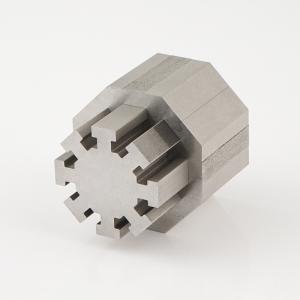
Add to Cart
Stainless Steel CNC Machined Parts Milling CNC Machining Parts Aluminum
Professional Manufacturer Custom Turning Machining Parts
Characteristics of CNC Machining
One of the defining strengths of CNC machining lies in its ability to consistently fabricate sturdy
parts using an extensive range of materials.
CNC machines are capable of processing virtually every engineering material.
In contrast to 3D printing, parts crafted through CNC machining exhibit fully-isotropic physical
properties, mirroring the properties of the bulk material from which they were machined.
CNC machining predominantly focuses on metals, serving purposes ranging from prototyping to
larger-scale production runs.
While machining plastics can present challenges due to their lower stiffness and lower melting
temperatures, there is value in employing CNC machining for crafting functional prototypes from
plastic materials before transitioning to larger-scale production through methods such as
injection molding.
Product Details
Cost Considerations for CNC Machining Materials
The cost of materials in CNC machining can fluctuate significantly due to the extensive array of
available options. Each material carries its unique price tag, and the inherent physical properties
of each material play a substantial role in determining machining costs.
For those seeking to manufacture metal components, Aluminum 6061 stands out as the most
cost-effective choice.
On the other hand, ABS ranks as the most budget-friendly option among materials.
As for the influence of machining complexity on costs, stainless steel serves as an illustrative example.
Its inherent hardness, surpassing that of aluminum, renders it more challenging to machine,
consequently elevating the overall machining expenses.
Here is a comprehensive overview of the most popular materials.
| The Most Popular Materials | |
| Name | Characteristics |
| Aluminum 6061 | Good strength-to-weight ratio, excellent machinability, low hardness |
| Stainless Steel 304 | Excellent mechanical properties, resistant to corrosion & acid, relatively difficult to machine |
| Brass C360 | High ductility, excellent machinability, good corrosion resistance |
| ABS | Excellent impact resistance, good mechanical properties, susceptible to solvents |
| Nylon (PA6 & PA66) | Excellent mechanical properties, high toughness, poor moisture resistance |
| POM (Delrin) | High stiffness, excellent thermal & electrical properties, relatively brittle |




| Surface Finishes | ||
| Name | Applicable to | Machining marks |
| As machined | Metals, Plastics | Visible, light surface scratches |
| Smooth machining | ||
| Fine machining | Metals | Slightly visible |
| Polishing | Metals | Removed on primary surfaces |
| Bead blasting | Metals | Removed for non-cosmetic, removed on primary surfaces for cosmetic |
| Brushing | Metals | |
| Anodizing Type II | Aluminum | |
| Anodizing Type III | Aluminum | Visible under anodizing |
| Black oxide | Copper, Stainless steel, Alloy steel, Tool steel, Mild steel | Visible |
| Powder coating | Metals | Removed |
| Brushed + electropolishing | Stainless steel | Removed on Primary surfaces |
Specialist Industries
CNC machining stands as a prevalent subtractive manufacturing method, with a vast array of
industries relying heavily on its capabilities.
Prominent sectors that extensively employ CNC machining encompass aerospace,automotive,
aviation, transportation, and various critical domains.
For instance, the aerospace industry demands the utmost precision in crafting airplane components
to guarantee flawless functionality and adherence to design specifications.

Company Profile


7 Key Advantages of CNC Machining
1. Minimal to Zero Material Waste: CNC machining stands out for its efficiency and the minimal
wastage it generates.
Thanks to its precision and accuracy, properly designed parts rarely result in faulty cuts, significantly
reducing the need to discard damaged components.
CNC machines excel at precise cuts and angles, minimizing material waste.
2. Exceptional Accuracy and Defect-Free Results: Precision is one of the primary benefits of CNC
machining. With precise computer instructions guiding the process, CNC machines consistently
produce identical, closely matching results.
This accuracy is especially valuable for creating parts with tight tolerances, virtually eliminating
human errors.
3. Rapid and Efficient Production: CNC machining offers remarkable speed and efficiency in production.
These machines can manufacture products at a much faster rate than traditional methods, and some
can even load and unload billets without human intervention.
This leads to substantial cost savings and increased productivity while ensuring consistent part quality.
4. Faster Assembly: Components produced through CNC machining are easier to assemble.
Thanks to the precision and consistency of CNC processes, companion parts fit together exactly as
designed in the computer model.
The quick machining process reduces waiting time for completed parts, streamlining the assembly
process with minimal need for extensive fitting and adjustment.
5. Enhanced Safety: CNC machining enhances safety in manufacturing by removing significant risks
from the shop floor.
Automation eliminates many hazards associated with manual machining, and the enclosed nature of
CNC machines further reduces the risk of injury.
6. Reduced Energy Consumption: CNC machining is energy-efficient, using significantly less electricity
compared to older manufacturing processes.
According to the EPA, CNC machining consumes only about one-seventh of the energy used by
traditional methods.
The combination of speed and lower power consumption makes CNC machines environmentally friendly.
7. Lower Production Costs: CNC machining is cost-effective, efficient, and precise. It also utilizes fewer
raw materials compared to conventional machining.
Transitioning to CNC technology can lead to reduced errors, lower production expenses, and ultimately
lower product costs, making it an economically attractive choice for manufacturing parts and products.